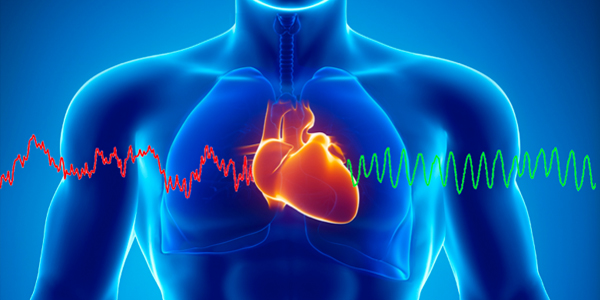
A number of years ago, I cared for a patient with a unique
heart problem. Her dog of many years was out in the backyard and unfortunately
ended up with a paw stuck in a metal trap set for a raccoon. My patient
ran to the dog’s aid. Frantic from being caught in the trap, the dog
bit my patient. She was ultimately able to free the animal, but as she
returned to her house she suddenly felt dizzy and collapsed.
_________________________
Fortunately, someone started CPR immediately. Paramedics arrived in a few minutes to deliver a life-saving shock to her heart to stop a cardiac arrest. In the hospital, we found that the bottom two-thirds of her heart had dilated and stopped pumping, but her coronary arteries were normal. The diagnosis was stress-related heart disease (cardiomyopathy), which is also called Takotsubo cardiomyopathy, or broken-heart syndrome. As her stress decreased over the next few weeks, her heart completely recovered.
This is just one story illustrating the fact that mind and heart are intimately connected. In some circumstances, our hearts can fail and go into cardiac arrest from stress alone. With this concept in mind, many discoveries about stress and heart disease are more understandable. For example, I have previously written about how relationships with our spouses and how we control our emotions can directly impact our heart health, independent of traditional heart risk factors.
A recent study summarized 26 prior studies that examined the influence of workplace stress on heart disease. The authors found that a hostile work environment increased risk of heart attack, stroke, and high blood pressure from 13 percent to 20 percent. The effects of workplace stress were even more notable in men. In Japan, the term Karoshi means “death from overwork,” and is based on the phenomenon of sudden death in previously healthy people who suffered either a stroke or heart attack when exposed to severe workplace stress.
It’s clear that stress from any source, and our approach in handling it, can significantly contribute to our outlook and wellbeing. Knowing this can help us make lifestyle changes to reduce our risks. However, it is also possible that in understanding the adverse signaling between the brain and heart during severe stress, we can help the heart avoid disease and survive.
Brain and Heart: A Dynamic Relationship
A recent study provided some clues to the dynamic between the heart and the mind. Our brains create a protein called brain-derived neurotrophic factor (BDNF), which helps the brain and nervous system grow, helps nerves communicate, and is involved in the ability of nerves to change and adapt. Simply put, it functions in nervous system parts that are needed for repair, learning, and memory. In addition, when levels of this protein are high, BDNF is thought to be a natural antidepressant. A team of researchers from Johns Hopkins University recently learned more about how BDNF signals the heart and affects its function. BDNF binds to the heart through a receptor called TrkB (tropomyosin-related kinase receptor B). As BDNF increases and binds toTrkB, it helps heart blood vessels and nerves grow and develop.
The team of researchers created a genetically altered mouse that did not have functioning TrkB receptors on the heart. Because of this, the mouse could not response to the brain’s release of the BDNF protein. What happened during the experiment was profound; the hearts in mice that were not sensitive to BDNF became weaker, stiffer, and less able to relax and receive blood with each beat. These negative effects on the heart increased with physical stress. Another way the brain works on the heart when it encounters stress is by stimulating nerves to release adrenalin. Adrenalin makes the heart beat quicker and with more force. When BDNF is low, or the heart is not receptive to it, the heart remains sensitive to adrenalin. The combination is problematic, because a heart that is not sensitive to BDNF and is unable to adapt to stress becomes exposed to stress and can rapidly weaken and fail.
A Protein Linked to Many Heart Conditions
These findings may help explain many heart conditions. For example:
1. Depression is a well-known cause of heart disease. Depression also increases risk of dying after a heart attack, heart failure, or atrial fibrillation, regardless of your treatment. Perhaps low levels of BDNF can explain some of these associations.
2. Certain chemotherapies for cancer can cause the heart to fail. For this reason, many patients undergoing chemotherapy have regularly scheduled ultrasounds of the heart. Cancer itself is a great stress to mind and body. Also, some chemotherapies block the heart receptor to the BDNF protein, essentially recreating the Johns Hopkins’ experiment and blocking BDNF signal pathways from the brain and heart.
3. We also know that some endurance athletes develop premature heart failure and heart arrest. As I explained in a prior column, we do not fully understand why the most athletically fit are not the most fit when it comes to survival and heart disease. The Hopkins study may provide clues. Perhaps athletes who have repeated exposure to adrenalin have acquired or genetic interruption in the brain-heart BDNF signaling pathway that predisposes their hearts to fail.
4. Release of BDNF and response to it may explain why some people with heart failure recover, while others experience progressive deteriorating disease. Clearly, this pathway may be used to create drugs that can replicate BDNF, improve the heart’s response to it, or increase its natural production. In the meantime, there are possible ways to raise your natural BDNF. How to Raise Levels of This Heart-Protective Protein
How to Raise Levels of This Heart-Protective Protein
1. Eat a diet rich in whole foods – fruits and vegetables. Studies show that a diet that is high in fat or refined sugar lowers brain BDNF.
2. Reduce your meal size and occasionally fast to raise BDNF, research suggests. This may explain emerging research that has shown positive health benefits such as lower blood pressure, cholesterol, and diabetes risk with occasional or regular fasting.
3. In as little as six weeks, increasing your consumption of omega-3 polyunsaturated fatty acids can increase BDNF, studies indicate. Foods rich in these include green leafy vegetables, nuts, fish, and seeds.
4. Physical exercise increases brain BDNF, according to studies. Moderate, rather than extreme, physical exercise appears to have the greatest long-term health benefit. Physical exercise also is a power antidepressant, perhaps in part through raising BDNF.
5. Your quality of sleep can also impact BDNF. I recently wrote about sleep and heart disease. Research shows that when you get restorative, quality sleep you can increase your BDNF. For most of us, this appears to be between 7 and 8 hours a night.
6. One important way to raise the amount of natural BDNF is through relationships. Our health needs quality relationships with spouses, children, and friends. Our children need quality relationships with their parents. Studies show that positive and sustaining relationships can raise BDNF.
This research is exciting. It provides another glimpse into the complex and real interactions between body and mind. As science catches up to clinical observations, we learn of the complex signaling processes that govern them. By understanding these processes, we can understand the role of lifestyle changes and interventions and develop new therapies to prevent disease.





